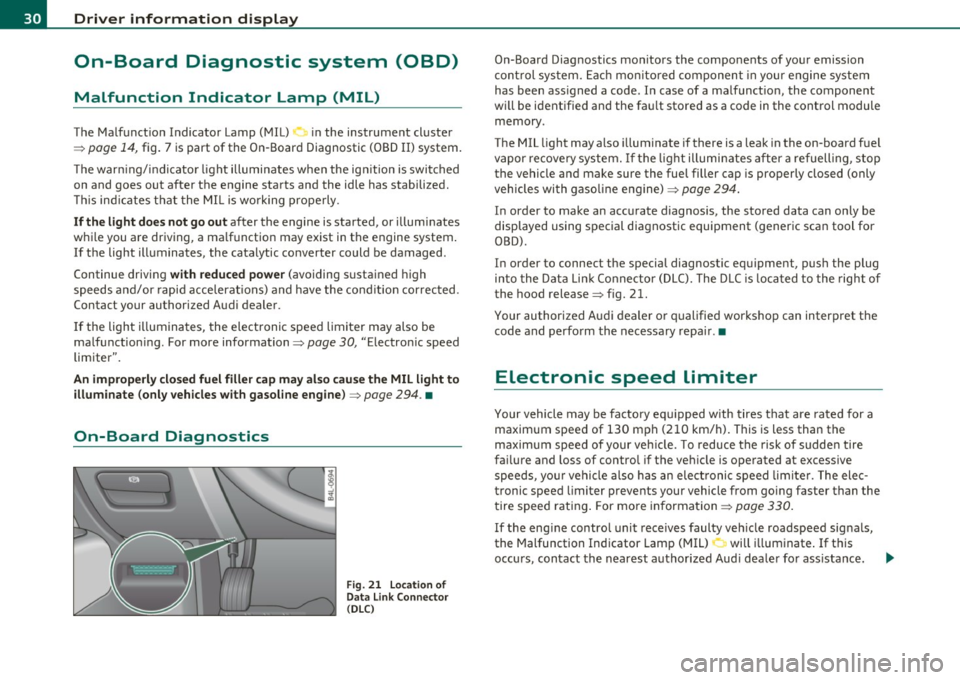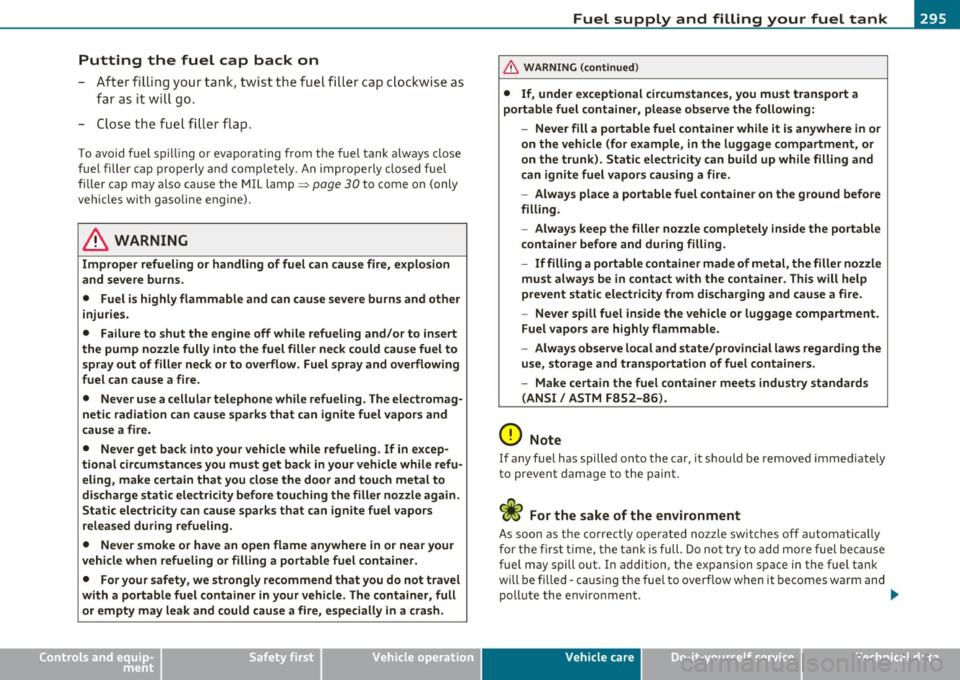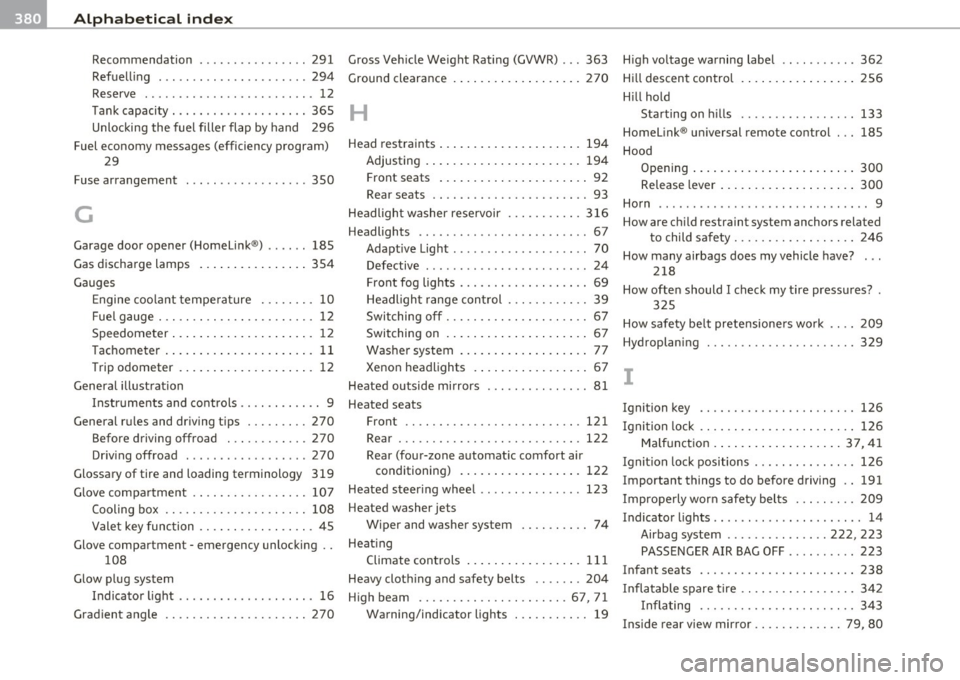fuel cap release AUDI Q7 2011 Owner´s Manual
[x] Cancel search | Manufacturer: AUDI, Model Year: 2011, Model line: Q7, Model: AUDI Q7 2011Pages: 392, PDF Size: 93.29 MB
Page 32 of 392

Driver information display
On-Board Diagnostic system (OBD)
Malfunction Indicator Lamp (MIL)
The Malfunction Indicator Lamp (MIL) • in the instrument cluster
::::>
page 14, fig. 7 is part of the On-Board Diagnostic (OBD II) system.
Th e warn ing/indicator light illuminates when the ignition is switched
on and goes out after the engine starts and the idle has stabilized.
Thi s ind icates that the MIL is working properly.
If
the light does not go out after the engine is started, or illuminates
while you are driving , a ma lfunction may exist in the engine system.
If the light illuminates, the catalytic converter could be damaged.
Continue driving
with reduced power (avoiding sustained high
speeds and/or rapid accelerat ions) and have the condition corrected .
Contact your authorized Audi dealer .
If the light i lluminates, the electronic speed limiter may also be
malfunctioning. For more information::::>
page 30, "Electronic speed
limiter".
An improperly closed fuel filler cap may also cause the MIL light to
illuminate (only vehicles with gasoline engine)::::>
page 294. •
On-Board Diagnostics
Fig . 21 Location of
Data Link Connector
( DLC )
On-Board Diagnostics monitors the components of your emission
control system. Each monito red component in you r engine system
has been ass igned a code. I n case of a malfunct ion, the component
wi ll be ident ified and the fau lt stored as a code in the control module
memory .
The MIL light may also illuminate if there is a leak in the on-board fuel
vapor recovery system. If the light illuminates after a refuelling, stop
the vehicle and make sure the fuel filler cap is properly closed (only
vehicles with gasoline engine)::::>
page 294.
In order to make an accurate diagnosis, the stored data can only be
displayed using special diagnostic equipment (generic scan tool for
OBD).
In order to connect the special diagnostic equipment, push the plug
into the Data Link Connector (DLC). The DLC is lo cated to the right of
the hood release
::::> fig. 21.
Your authorized Audi dealer or qualified workshop can interpret the
code and perform the necessary repair .•
Electronic speed limiter
Your vehicle may be factory equ ipped w ith tires that are rated for a
maximum speed of 130 mph (210 km/h). This is less than the
maximum speed of your veh icle. To reduce the risk of sudden tire
failure and loss of control if the vehicle is operated at excessive
speeds, your vehicle also has an electronic speed limiter . The elec
tronic speed limiter prevents your vehicle from going faster than the
tire speed rating . For more information ::::>
page 330.
If the engine control unit receives faulty vehicle roadspeed signals,
the Malfunction Indicator Lamp (MIL)
0 will illuminate . If this
occurs, contact the nearest authorized Aud i dea ler for ass istance.
~
Page 297 of 392

Putting the fuel cap back on
- After filling your tank, twist the fuel fi ller cap c lockwise as
f ar as it w ill go.
- Close t he fue l fi ller flap.
To avoid fuel spi lling or evapo rating from the f uel tank a lways close
fue l filler cap properly and comp lete ly . An impro perly closed fuel
filler cap may also ca use the MIL lamp~
page 30 to come on (only
vehicle s wi th gaso lin e e ngine).
& WARNING
Improper refueling or handling of fuel can cause fire, explosion
and severe burns .
• Fuel i s highly flammable and can cause severe burns and other
injuries.
• Failure to shut the engine off while refueling and /or to insert
the pump nozzle fully into the fuel filler neck could cause fuel to spray out of filler n eck or to overflow. Fuel spray and ov erflowing
fuel can cause a fire.
• Never use a cellular telephone while refueling. The electromag
netic radiation can cau se sparks that can ignite fuel vapors and
cause a fire.
• Never get back into your vehicle while refueling. If in excep
tional cir cumstan ces you must get ba ck in your v ehicle while refu
eling, make certain that you close the door and touch metal to
discharge static electricity before touching the filler nozzle again .
Static electricity can cause sparks that can ignite fuel vapo rs
released during refueling.
• Never smoke or have an open flame anywhere in o r near your
vehicle when refueling or filling a portable fue l container.
• For your safety , we strongly recommend that you do not travel
with a portable fuel container in your vehicle . The container , full
or empty may leak and could cau se a fire , especially in a crash.
Safety first
Fuel supply and filling your fuel tank
& WARNING (co ntinued )
• If, under exceptional circumstances , you must tran sport a
portable fuel container, please observe the following:
-Never fill a portable fuel container while it is anywhere in or
on the vehicle (for example, in the luggage compartment, or
on the trunk ). Static electricity can build up while filling and
can ignite fuel vapors causing a fire .
- Always place a portable fuel container on the ground before
filling .
- Always keep the filler nozzle completel y inside the portable
container before and during filling.
- If filling a portable container made of metal, the filler nozzle must always be in contact with the container. This will help
prevent static ele ctricity from discharging and cause a fire .
- Ne ver spill fuel inside the vehicle or luggage compartment .
Fuel vapor s are highly flammable.
- Always observe local and state /provincial laws regarding the
use, storage and tran sportation of fuel containers .
-Make certain the fuel container meets industry standards
( ANSI / ASTM F852-86 ).
0 Note
If any f uel has spilled o nto the ca r, it should be remove d immed iate ly
to prevent damage to the paint.
f or t he firs t time, the t ank i s full. Do no t try to ad d mo re fuel bec ause
fue l may spill out. In addition, the expansion space in the fuel tank
w ill be fi lled -caus ing the fue l to overf low when it becomes wa rm and
poll ute the enviro nment . .,_
Vehicle care Technical data
Page 382 of 392

--~A~l± p ~ h~ a~ b'..::e ~t~ i~c ~a ~l ....'..i~n ~d ~e:..:x~ ------------------------------------------
Recommendation ..... .... .... ... 291
Refuel ling ...................... 294
Reserve ..................... .... 12
Tank capacity . ............. ...... 365
Unlocking the fue l filler flap by hand 2 96
Fuel economy messages (efficiency program)
29
Fuse arrangement ... .. .. ..... ...... 350
G
Garage door opener (Homelink®) ...... 185
Gas d ischa rge lamps .. .... ... ... .. .. 354
Gauges
Engine coo lant tempe rature ........
10
Fue l gauge . .. .. .. .. .. .. .... ...... 12
S peedometer ... .. .. ...... .. .. . ... 1 2
Tachometer . ... .... .. .... .. .. . ... 1 1
Trip odometer ... .... ..... ... .. .. . 1 2
General illust rat ion
Inst ruments and co ntrols ............ 9
General rules and dr iving tips .........
270
Before driving offroad ... .... ..... 270
Dr iv ing offroad .................. 270
Glossary of tire and loading terminology 319
Glove compa rtme nt ................. 1 07
Cooling box ..................... 108
Valet key func tion .... .. .... .... .. . 45
Glove compartment - emergency unlocking ..
108
Glow plug system
Indicato r light ................ ....
16
Gradient angle ..................... 270
Gross Vehicle Weight Rating (GVWR) ... 363
Ground clearance ...... ...... .. .. ... 2 70
H
Head restraints ... .. ..... ..... ..... . 19 4
Adjusting . .... .. ..... .. .. .. .. ... 194
Front seats ... ...... ... . ... .. .. . . 92
Rear seats .. ..................... 93
Headligh t washer rese rvoir .......... . 316
Headlights ... ... ... .... .. .. .. .. .. .. 67
Adaptive Light ......... ........ ... 70
Defective . . . . . . . . . . . . . . . . . . . . . . . . 24
Front fog lights ................... 69
Headlight range con trol ... ........ . 39
Switching off ..................... 67
Switching on .... ..... .. . ... .... .. 6 7
Was her system .. ..... .. . ... .... .. 77
Xenon headlights . ... .. .. ...... ... 67
Heated outside mirrors ............... 81
Heated seats
Front
121
Rear ... ................. .. .. .. . 122
Rear (four-zone automat ic comfort air
conditioning) ..... .... . ... .. .. .
122
Heated steer ing whee l ..... ... ....... 123
Heated washer jets
Wiper and washer system .. .. .. .. ..
74
Heat ing
Climate controls ...... ..... .. .. ..
111
Heavy clot hing and safety belts ....... 204
H igh beam ...................... 67, 71
Warning/indicator l ights . .. .. .. .. .. 19
H igh voltage warning label .. .. .. .. ... 362
H ill descent control
H ill hold 256
Sta rting on h ills 133
Homelink ® uni versal remote control ... 185
Hood
Ope ning ... .... ... ... . .... .... ..
300
Release lever ... .. .. .. ... .. .... .. 300
Horn .................. .... ... ...... 9
How are child restra int system anchors related
to child safety ............ .. .. ..
2 46
How many airbags does my vehicle have? ...
218
How ofte n should I check my t ire pressures? .
325
How safety belt pre te nsione rs wo rk .. .. 20 9
Hydroplaning . .... .. .. .... ......... 329
I
Ignition key ........... ...... .. . ... 126
Igni tion lock ....................... 126
Ma lf u nct ion .... .. .. .. .. .. ..... 37, 4 1
Ignition lock positions . .... .. .... .. .. 126
Important things to do before driving .. 191
Imprope rly wor n safety bel ts ... .. .. .. 209
Indicator lights . . . . . . . . . . . . . . . . . . . . . . 14
Airbag system ...... .... .... . 222, 223
PASS ENG ER A IR BAG OFF ...... . ... 223
In fant seats ....................... 238
Inflatable spare tire ................. 342
Inflating ....................... 343
Inside rear view mirror .. ........... 79, 80